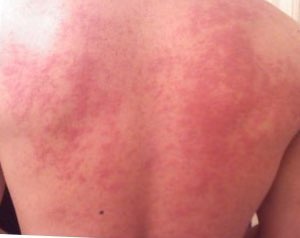Related Research Articles

Allergies, also known as allergic diseases, refer to a number of conditions caused by the hypersensitivity of the immune system to typically harmless substances in the environment. These diseases include hay fever, food allergies, atopic dermatitis, allergic asthma, and anaphylaxis. Symptoms may include red eyes, an itchy rash, sneezing, coughing, a runny nose, shortness of breath, or swelling. Note: food intolerances and food poisoning are separate conditions.

House dust mites are various species of acariform mites belonging to the family Pyroglyphidae that are found in association with dust in dwellings. They are known for causing allergies.
A radioallergosorbent test (RAST) is a blood test using radioimmunoassay test to detect specific IgE antibodies in order to determine the substances a subject is allergic to. This is different from a skin allergy test, which determines allergy by the reaction of a person's skin to different substances.

Sulfites or sulphites are compounds that contain the sulfite ion, SO2−
3. The sulfite ion is the conjugate base of bisulfite. Although its acid is elusive, its salts are widely used.

A food allergy is an abnormal immune response to food. The symptoms of the allergic reaction may range from mild to severe. They may include itchiness, swelling of the tongue, vomiting, diarrhea, hives, trouble breathing, or low blood pressure. This typically occurs within minutes to several hours of exposure. When the symptoms are severe, it is known as anaphylaxis. A food intolerance and food poisoning are separate conditions, not due to an immune response.
Rose Marie Valdes Pangborn was a Mexican-American food scientist, food technologist, professor, and a pioneer in the field of sensory analysis of food attributes. She worked as a sensory scientist in the Experiment Station, Step VIII, served for 35 years at the University of California, Davis. She co-founded the Association for Chemoreception Sciences (ACHEMS), and the Sensory Reception Scholarship Fund (SSSF).

Soy allergy is a type of food allergy. It is a hypersensitivity to ingesting compounds in soy, causing an overreaction of the immune system, typically with physical symptoms, such as gastrointestinal discomfort, respiratory distress, or a skin reaction. Soy is among the eight most common foods inducing allergic reactions in children and adults. It has a prevalence of about 0.3% in the general population.
Cross-reactivity, in a general sense, is the reactivity of an observed agent which initiates reactions outside the main reaction expected. This has implications for any kind of test or assay, including diagnostic tests in medicine, and can be a cause of false positives. In immunology, the definition of cross-reactivity refers specifically to the reaction of the immune system to antigens. There can be cross-reactivity between the immune system and the antigens of two different pathogens, or between one pathogen and proteins on non-pathogens, which in some cases can be the cause of allergies.

Lotion is a low-viscosity topical preparation intended for application to the skin. By contrast, creams and gels have higher viscosity, typically due to lower water content. Lotions are applied to external skin with bare hands, a brush, a clean cloth, or cotton wool.
Nambudripad's Allergy Elimination Techniques (NAET) is a form of alternative medicine which proponents claim can treat allergies and related disorders. The techniques were devised by Devi Nambudripad, a California-based chiropractor and acupuncturist, in 1983, drawing on a combination of ideas from applied kinesiology, acupuncture, acupressure, nutritional management, and chiropractic methods.

A tree nut allergy is a hypersensitivity to dietary substances from tree nuts and edible tree seeds causing an overreaction of the immune system which may lead to severe physical symptoms. Tree nuts include almonds, Brazil nuts, cashews, chestnuts, filberts/hazelnuts, macadamia nuts, pecans, pistachios, shea nuts and walnuts.

The Institute of Food Technologists (IFT) is an international, non-profit scientific society of professionals engaged in food science, food technology, and related areas in academia, government and industry. It has more than 17,000 members from more than 95 countries.
Bernard J. Liska was an American food scientist who was involved in the creation of the Food Science Department at Purdue University in West Lafayette, Indiana. He also served as president of the Institute of Food Technologists in 1984–85 and was scientific editor of the Journal of Food Science from 1970 to 1981.

Shridhar Krishna Sathe was an Indian-born American scientist who was a distinguished professor of food science at Florida State University. He is widely cited as an authority on the role of proteins in food allergy.

Thomas Alexander Evelyn Platts-Mills, FRS son of British member of parliament and barrister John Platts-Mills, is a British allergy researcher and director of the Division of Allergy and Clinical Immunology at the University of Virginia School of Medicine.
Fred Ross Shank II was the Director of the Center for Food Safety and Applied Nutrition of the Food and Drug Administration for nearly ten years before he became Senior Advisor to the Commissioner for External Academic Affairs in January 1998. Before joining FDA in 1978, Shank performed program evaluations and served as a nutrition specialist with the Food and Nutrition Service for domestic food assistance programs at the U.S. Department of Agriculture. Shank earned his doctorate in nutrition at the University of Maryland, College Park. He has authored or co-authored numerous papers and has made many presentation on public health, nutrition and food safety. His best known work was the implementation of the Nutrition Labeling and Education Act in 1990. In 1994, he was the recipient of the Babcock-Hart Award.

Asthma & Allergy Friendly is a registered certification mark operated by Allergy Standards Limited in association with not-for-profit asthma and/or allergy organizations. They specialise in labelling products which have been put through and have passed standardised testing. The Asthma & Allergy Friendly Certification Program was created to scientifically test and identify consumer products that are more suitable for people with asthma and allergies.

Ara h 1 is a seed storage protein from Arachis hypogaea (peanuts). It is a heat stable 7S vicilin-like globulin with a stable trimeric form that comprises 12-16% of the total protein in peanut extracts. Ara h 1 is known because sensitization to it was found in 95% of peanut-allergic patients from North America. In spite of this high percentage, peanut-allergic patients of European populations have fewer sensitizations to Ara h 1.
Suranjith Seneviratne is a doctor from Sri Lanka who practices in allergology and immunology.
References
- 1 2 3 4 "Susan L. "Sue" Hefle". Legacy.com. Retrieved August 13, 2018.
- 1 2 "Allergens & Labeling: Got it Under Control?". FoodEngineeringMag.com. March 6, 2006. Retrieved August 13, 2018.
- ↑ "Protest in Oakland on Genetically Altered Food". SFGate.com. December 14, 1999. Retrieved August 13, 2018.
- ↑ "IFF Fellows (2004)" . Retrieved August 13, 2018.